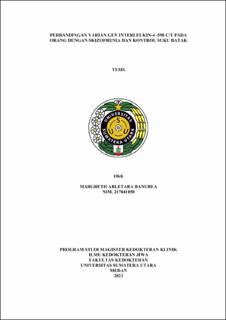| dc.description.abstract | Background: Schizophrenia is a serious mental disorder characterized by
disturbances in thinking, perception, emotion, and behavior. Although the exact
causes are unknown, research suggests that both genetic and environmental
factors contribute to its development. Besides, the interleukin-4 (IL-4) 590 C/T
polymorphism comprises a variation in the DNA sequence at position 590 of the
IL-4 gene. The IL-4 gene encodes interleukin-4, a cytokine involved in immune
response and inflammation. This genetic polymorphism has been associated with
various medical conditions, including neurological and psychiatric disorders. The
relationship between IL-4 590 C/T polymorphism and schizophrenia has been
previously examined.
Methods: This comparative analytic research used a cross-sectional design to
make a comparison between the Batak people with Schizophrenia (ODS) group
and healthy control. DNA isolation and examination of Polymerase Chain
Reaction – Restriction Fragment Length Polymorphism (PCR-RFLP) were
performed.
Results: The Chi-Square test with Yates' correction showed no significant
differences in the frequency of allele occurrence between ODS and control groups
(p=0.1). Additionally, logistic regression analysis indicated a p-value of 0.415 for
genotype (CC vs CT), with an odds ratio (OR) of 0.743 and a 95% confidence
interval (CI) ranging from 0.364-1.517. The p-value for genotype CC vs TT was
0.002, with an OR=0.433 and a 95% CI of 0.257-0.730.
Conclusion: This research identified a significant relationship, specifically in the
TT genotype when compared to CC | en_US |


